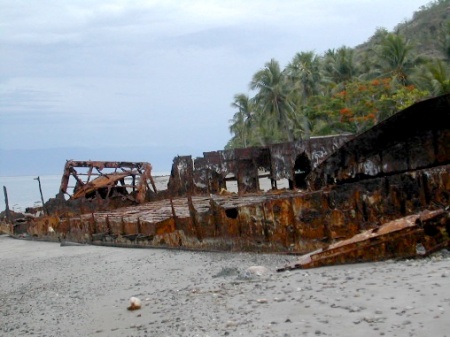On the issue of a detention center in East Timor for those seeking asylum in Australia: continued insensitivity by both sides, especially in what relates to the eventual location. One Timorese minister has suggested what he deems to be a “win-win” idea to resolve the impasse – put them on the Island of the Island.
What follows is some historical perspective on the island that is the namesake of this blog, prisons and boat people.
Many of the deportados to Portuguese Timor in the late 1920s and early 1930s era were sent first to Atáuro Island. Citing a “letter from Timor” describing the arrival of the boat Pedro Gomes and its passengers, published in A Voz de Macau on November 17, 1931 (my translation):
I see some faces in the shadows of pain! Two of them, strong young men, humble, the honest kind, cry, weep…One of them, over all the others, has tears streaming down! That shocks me, it makes me shudder, angers!
There was somebody who reminded, and well, that Timor was now the “Fatima of the deportados!”… And there were there some hundreds of mouths of deportados. And what deportados! There were there men in whose hands the destiny of the country was trusted! And, the names Utra Machado, Bossa da Viega, Simões Raposo, Helder Ribeiro, Coronel Antunes Major Batista occur to us, who are going to serve their deportation on that island, Pulau Kambing [Goat Island – Ataúro], veiled now by a slow fog of agony!
Years later, some deportados actually escaped from the ship carrying them to Portuguese Timor, made their way to Kupang, and were taken in by Australia. (If I find the reference to their daring escape in my files, I will add it.)
Also, many of the Portuguese deportados who helped Australia in World War II were evacuated and interned in Australia, some repatriated (voluntarily or involuntarily?) after the War (see Annex D of this Ernie Chamberlain monograph). “Boat people” and “asylum seekers” via Timor – then and now.
Ataúro Island was used as a prison by the Portuguese well after this wave of deportados.
They exiled liurais accused of collaborating with the Japanese there, and as well as some of the people accused of rebellion in 1959. In both instances many died of starvation. Some accuse that prisoners were fed crushed glass in their cornmeal to finish them off more quickly. Ruy Cinatti immortalized this moment in his poem “Segunda Meditação” or “Second Meditation” (my translation of the excerpt):
Seven times seven, times ten, died
in Atauro,
burned in the sun,
perishing of hunger like dry corn
on a glowing grill
But the insensitivity does not end there.
I have friends who were exiled to Ataúro by the Indonesians. I do not want to trivialize their suffering by attempting to capture it here – there is no way to describe what hunger does to a child physically and emotionally.
And so to put it simply: does an independent East Timor want to re-veil Ataúro Island in another “slow fog of agony”?
